fuel KIA Soul 2013 1.G Owner's Manual
[x] Cancel search | Manufacturer: KIA, Model Year: 2013, Model line: Soul, Model: KIA Soul 2013 1.GPages: 393, PDF Size: 8.76 MB
Page 7 of 393
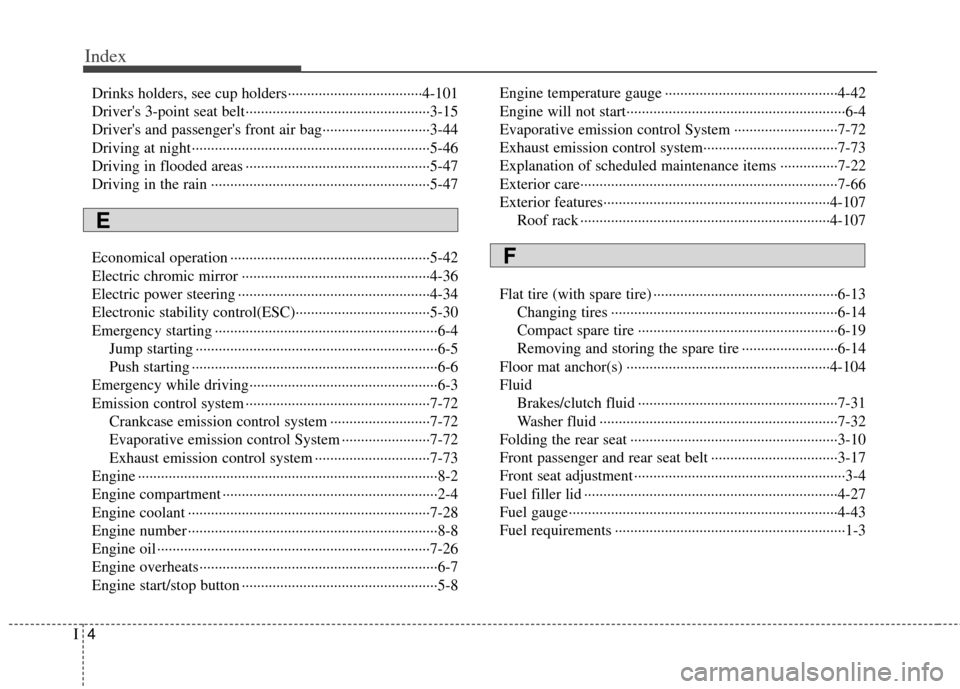
Index
4I
Drinks holders, see cup holders··················\
·················4-10\
1
Driver's 3-point seat belt··················\
··················\
············3-15
Driver's and passenger's front air bag··················\
··········3-44
Driving at night··················\
··················\
··················\
········5-46
Driving in flooded areas ··················\
··················\
············5-47
Driving in the rain ··················\
··················\
··················\
···5-47
Economical operation ··················\
··················\
················5-42
Electric chromic mirror ··················\
··················\
·············4-36
Electric power steering ··················\
··················\
··············4-34
Electronic stability control(ESC)··················\
·················5-30\
Emergency starting ··················\
··················\
··················\
····6-4Jump starting ··················\
··················\
··················\
·········6-5
Push starting ··················\
··················\
··················\
··········6-6
Emergency while driving··················\
··················\
·············6-3
Emission control system ··················\
··················\
············7-72 Crankcase emission control system ··················\
········7-72
Evaporative emission control System ··················\
·····7-72
Exhaust emission control system ··················\
············7-73
Engine ··················\
··················\
··················\
··················\
······8-2
Engine compartment ··················\
··················\
··················\
··2-4
Engine coolant ··················\
··················\
··················\
·········7-28
Engine number ··················\
··················\
··················\
···········8-8
Engine oil ··················\
··················\
··················\
·················7-26\
Engine overheats··················\
··················\
··················\
········6-7
Engine start/stop button ··················\
··················\
···············5-8 Engine temperature gauge ··················\
··················\
·········4-42
Engine will not start··················\
··················\
··················\
···6-4
Evaporative emission control System ··················\
·········7-72
Exhaust emission control system··················\
·················7-73\
Explanation of scheduled maintenance items ···············7-22
Exterior care··················\
··················\
··················\
·············7-66
Exterior features··················\
··················\
··················\
·····4-107
Roof rack ··················\
··················\
··················\
···········4-107
Flat tire (with spare tire) ··················\
··················\
············6-13 Changing tires ··················\
··················\
··················\
·····6-14
Compact spare tire ··················\
··················\
················6-19
Removing and storing the spare tire ··················\
·······6-14
Floor mat anchor(s) ··················\
··················\
·················4-10\
4
Fluid Brakes/clutch fluid ··················\
··················\
················7-31
Washer fluid ··················\
··················\
··················\
········7-32
Folding the rear seat ··················\
··················\
··················\
3-10
Front passenger and rear seat belt ··················\
···············3-17
Front seat adjustment ··················\
··················\
··················\
·3-4
Fuel filler lid ··················\
··················\
··················\
············4-27
Fuel gauge··················\
··················\
··················\
················4-43
Fuel requirements ··················\
··················\
··················\
······1-3
E
F
Page 8 of 393

I5
Index
Fuses ··················\
··················\
··················\
··················\
······7-54Fuse/relay panel description··················\
··················\
··7-58
Instrument panel fuse ··················\
··················\
············7-55
Memory fuse ··················\
··················\
··················\
·······7-56
Gauge Engine temperature gauge··················\
··················\
·····4-42
Fuel gauge ··················\
··················\
··················\
···········4-43
GAW (Gross axle weight) ··················\
··················\
·········5-57
GAWR (Gross axle weight rating) ··················\
··············5-57
Glove box··················\
··················\
··················\
·················4-98\
GVW (Gross vehicle weight) ··················\
··················\
····5-57
GVWR (Gross vehicle weight rating) ··················\
·········5-57
Hazard warning flasher··················\
··················\
··············4-64
Hazardous driving conditions ··················\
··················\
····5-44
Headlamp escort ··················\
··················\
··················\
······4-65
Headrest(front) ··················\
··················\
··················\
···········3-6
Headrest(rear) ··················\
··················\
··················\
··········3-12
Hight adjustment··················\
··················\
··················\
······3-16
Highway driving ··················\
··················\
··················\
······5-48
Hill-start assist control ··················\
··················\
···············5-33
Hood··················\
··················\
··················\
··················\
·······4-25
Horn ··················\
··················\
··················\
··················\
·······4-35
How to use this manual ··················\
··················\
···············1-2 Indicator symbols on the instrument cluster ··················\
·1-6
Indicators and warnings ··················\
··················\
·············4-50
Inside rearview mirror ··················\
··················\
···············4-36
Instrument cluster ··················\
··················\
··················\
····4-40
Automatic transaxle shift position indicator ·············4-49
Engine temperature gauge··················\
··················\
·····4-42
Fuel gauge ··················\
··················\
··················\
···········4-43
Instrument panel illumination ··················\
·················4-40\
Manual transaxle shift indicator··················\
··············4-47
Odometer ··················\
··················\
··················\
·············4-43
Outside temperature ··················\
··················\
··············4-48
Speedometer ··················\
··················\
··················\
········4-41
Tachometer ··················\
··················\
··················\
··········4-41
Trip computer ··················\
··················\
··················\
······4-44
Warning and indicators ··················\
··················\
·········4-50
Instrument panel fuse··················\
··················\
·················7-55\
Instrument panel illumination··················\
··················\
····4-41
Instrument panel overview ··················\
··················\
··········2-3
Interior care··················\
··················\
··················\
··············7-71
Interior features··················\
··················\
··················\
······4-100 Ashtray ··················\
··················\
··················\
··············4-100
Cargo screen ··················\
··················\
··················\
······4-105
Cigarette lighter··················\
··················\
··················\
·4-100
Clothes hanger··················\
··················\
··················\
···4-103
Cup holder ··················\
··················\
··················\
·········4-101
Floor mat anchor(s) ··················\
··················\
·············4-104
Luggage net ··················\
··················\
··················\
·······4-104
G
H
I
Page 14 of 393
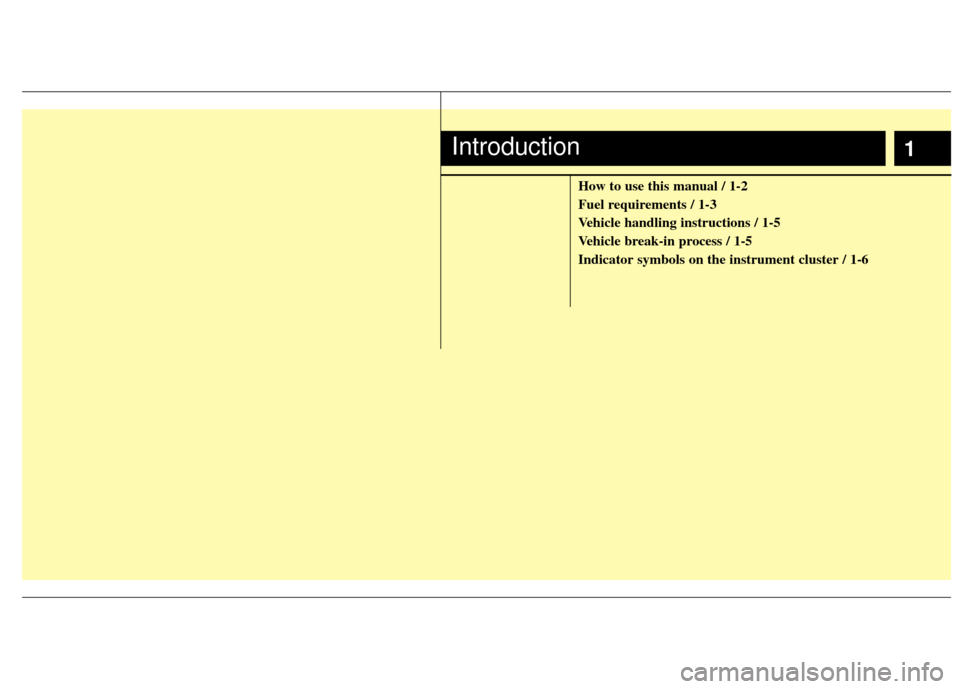
1
How to use this manual / 1-2
Fuel requirements / 1-3
Vehicle handling instructions / 1-5
Vehicle break-in process / 1-5
Indicator symbols on the instrument cluster / 1-6
Introduction
Page 16 of 393
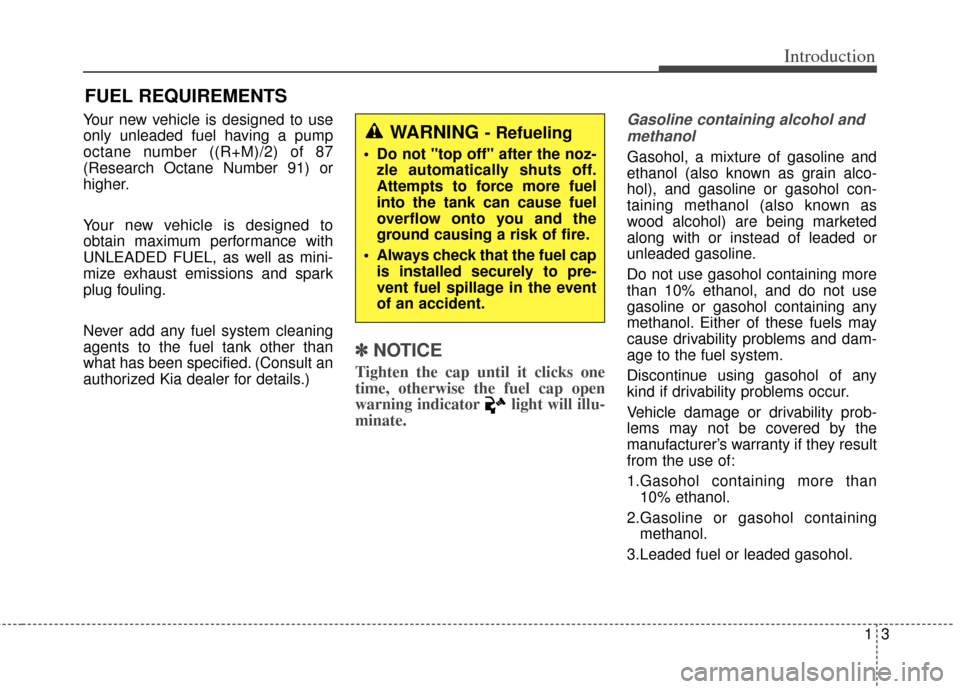
13
Introduction
Your new vehicle is designed to use
only unleaded fuel having a pump
octane number ((R+M)/2) of 87
(Research Octane Number 91) or
higher.
Your new vehicle is designed to
obtain maximum performance with
UNLEADED FUEL, as well as mini-
mize exhaust emissions and spark
plug fouling.
Never add any fuel system cleaning
agents to the fuel tank other than
what has been specified. (Consult an
authorized Kia dealer for details.)
✽ ✽NOTICE
Tighten the cap until it clicks one
time, otherwise the fuel cap open
warning indicator light will illu-
minate.
Gasoline containing alcohol and
methanol
Gasohol, a mixture of gasoline and
ethanol (also known as grain alco-
hol), and gasoline or gasohol con-
taining methanol (also known as
wood alcohol) are being marketed
along with or instead of leaded or
unleaded gasoline.
Do not use gasohol containing more
than 10% ethanol, and do not use
gasoline or gasohol containing any
methanol. Either of these fuels may
cause drivability problems and dam-
age to the fuel system.
Discontinue using gasohol of any
kind if drivability problems occur.
Vehicle damage or drivability prob-
lems may not be covered by the
manufacturer’s warranty if they result
from the use of:
1.Gasohol containing more than 10% ethanol.
2.Gasoline or gasohol containing methanol.
3.Leaded fuel or leaded gasohol.
FUEL REQUIREMENTS
WARNING - Refueling
• Do not "top off" after the noz- zle automatically shuts off.
Attempts to force more fuel
into the tank can cause fuel
overflow onto you and the
ground causing a risk of fire.
Always check that the fuel cap is installed securely to pre-
vent fuel spillage in the event
of an accident.
Page 17 of 393

Introduction
41
"E85" fuel is an alternative fuel com-
prised of 85 percent ethanol and 15
percent gasoline, and is manufac-
tured exclusively for use in Flexible
Fuel Vehicles. “E85” is not compati-
ble with your vehicle. Use of “E85”
may result in poor engine perform-
ance and damage to your vehicle's
engine and fuel system. Kia recom-
mends that customers do not use
fuel with an ethanol content exceed-
ing 10 percent.
✽ ✽NOTICE
Your New Vehicle Limited
Warranty does not cover damage to
the fuel system or any performance
problems caused by the use of “E85”
fuel.
Use of MTBE
Kia recommends avoiding fuels con-
taining MTBE (Methyl Tertiary Butyl
Ether) over 15.0% vol. (Oxygen
Content 2.7% weight) in your vehicle.
Fuel containing MTBE over 15.0%
vol. (Oxygen Content 2.7% weight)
may reduce vehicle performance and
produce vapor lock or hard starting.
✽ ✽NOTICE
Your New Vehicle Limited
Warranty may not cover damage to
the fuel system and any perform-
ance problems that are caused by
the use of fuels containing methanol
or fuels containing MTBE (Methyl
Tertiary Butyl Ether) over 15.0%
vol. (Oxygen Content 2.7% weight.)
Do not use methanol
Fuels containing methanol (wood
alcohol) should not be used in your
vehicle. This type of fuel can reduce
vehicle performance and damage
components of the fuel system.
Fuel Additives
Kia recommends that you use good
quality gasolines treated with deter-
gent additives such as TOP TIER
Detergent Gasoline, which help pre-
vent deposit formation in the engine.
These gasolines will help the engine
run cleaner and enhance perform-
ance of the Emission Control
System. For more information on
TOP TIER Detergent Gasoline,
please go to the website (www.top-
tiergas.com)
For customers who do not use TOP
Tier Detergent Gasoline regularly,
and have problems starting or the
engine does not run smoothly, addi-
tives that you can buy separately
may be added to the gasoline. If
TOP TIER Detergent Gasoline is not
available, one bottle of additive
added to the fuel tank at every 7,500
miles or 12 months is recommended.
Additives are available from your
authorized Kia dealer along with
information on how to use them. Do
not mix other additives.
Page 18 of 393
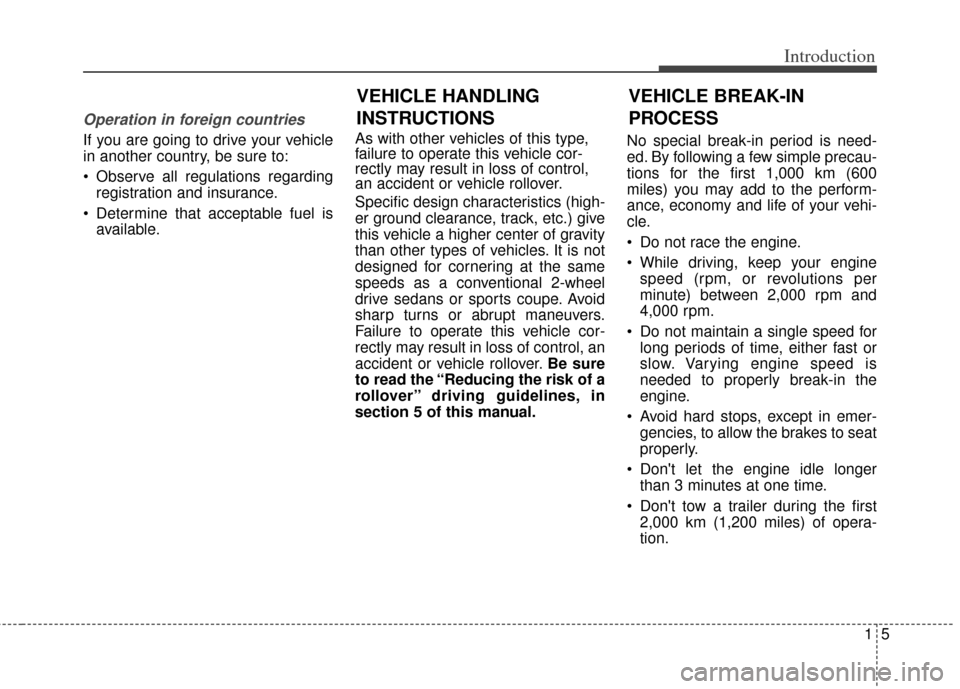
15
Introduction
Operation in foreign countries
If you are going to drive your vehicle
in another country, be sure to:
Observe all regulations regardingregistration and insurance.
Determine that acceptable fuel is available. As with other vehicles of this type,
failure to operate this vehicle cor-
rectly may result in loss of control,
an accident or vehicle rollover.
Specific design characteristics (high-
er ground clearance, track, etc.) give
this vehicle a higher center of gravity
than other types of vehicles. It is not
designed for cornering at the same
speeds as a conventional 2-wheel
drive sedans or sports coupe. Avoid
sharp turns or abrupt maneuvers.
Failure to operate this vehicle cor-
rectly may result in loss of control, an
accident or vehicle rollover.
Be sure
to read the “Reducing the risk of a
rollover” driving guidelines, in
section 5 of this manual. No special break-in period is need-
ed. By following a few simple precau-
tions for the first 1,000 km (600
miles) you may add to the perform-
ance, economy and life of your vehi-
cle.
Do not race the engine.
While driving, keep your engine
speed (rpm, or revolutions per
minute) between 2,000 rpm and
4,000 rpm.
Do not maintain a single speed for long periods of time, either fast or
slow. Varying engine speed is
needed to properly break-in the
engine.
Avoid hard stops, except in emer- gencies, to allow the brakes to seat
properly.
Don't let the engine idle longer than 3 minutes at one time.
Don't tow a trailer during the first 2,000 km (1,200 miles) of opera-
tion.
VEHICLE BREAK-IN
PROCESS
VEHICLE HANDLING
INSTRUCTIONS
Page 19 of 393
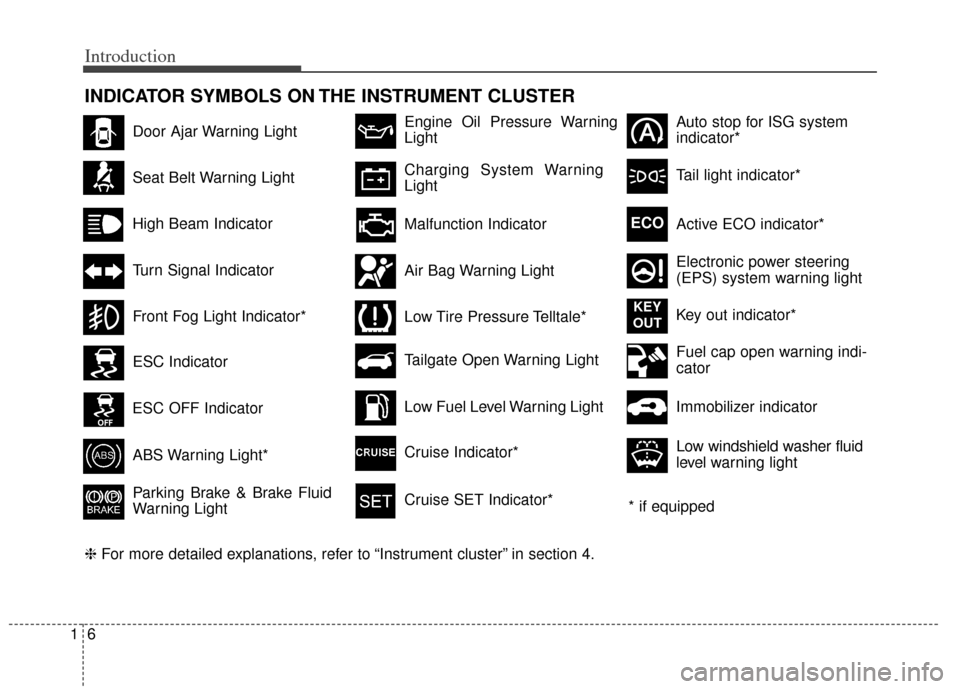
Introduction
61
INDICATOR SYMBOLS ON THE INSTRUMENT CLUSTER
Seat Belt Warning Light
High Beam Indicator
Turn Signal Indicator
ABS Warning Light*
Parking Brake & Brake Fluid
Warning Light
Malfunction Indicator
Low Fuel Level Warning Light Tailgate Open Warning Light
❈ For more detailed explanations, refer to “Instrument cluster” in section 4.
Charging System Warning
Light
Door Ajar Warning Light
Front Fog Light Indicator*
Engine Oil Pressure Warning
Light
Air Bag Warning Light
Low Tire Pressure Telltale*
Cruise Indicator*
Cruise SET Indicator*
ESC Indicator
ESC OFF Indicator
Tail light indicator*
Electronic power steering
(EPS) system warning light
Auto stop for ISG system
indicator*
Active ECO indicator*
ECO
Key out indicator*
KEY
OUT
* if equipped
Fuel cap open warning indi-
cator
Low windshield washer fluid
level warning light Immobilizer indicator
Page 21 of 393
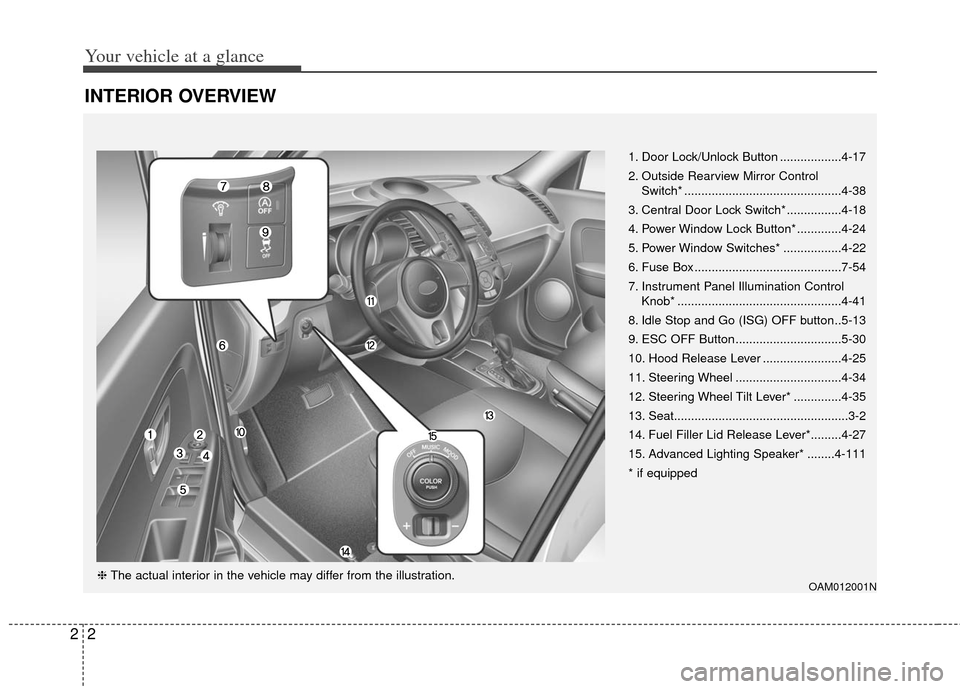
Your vehicle at a glance
22
INTERIOR OVERVIEW
1. Door Lock/Unlock Button ..................4-17
2. Outside Rearview Mirror Control Switch* ..............................................4-38
3. Central Door Lock Switch* ................4-18
4. Power Window Lock Button* .............4-24
5. Power Window Switches* .................4-22
6. Fuse Box ...........................................7-54
7. Instrument Panel Illumination Control Knob* ................................................4-41
8. Idle Stop and Go (ISG) OFF button..5-13
9. ESC OFF Button ...............................5-30
10. Hood Release Lever .......................4-25
11. Steering Wheel ...............................4-34
12. Steering Wheel Tilt Lever* ..............4-35
13. Seat...................................................3-2
14. Fuel Filler Lid Release Lever*.........4-27
15. Advanced Lighting Speaker* ........4-111
* if equipped
OAM012001N❈ The actual interior in the vehicle may differ from the illustration.
Page 80 of 393
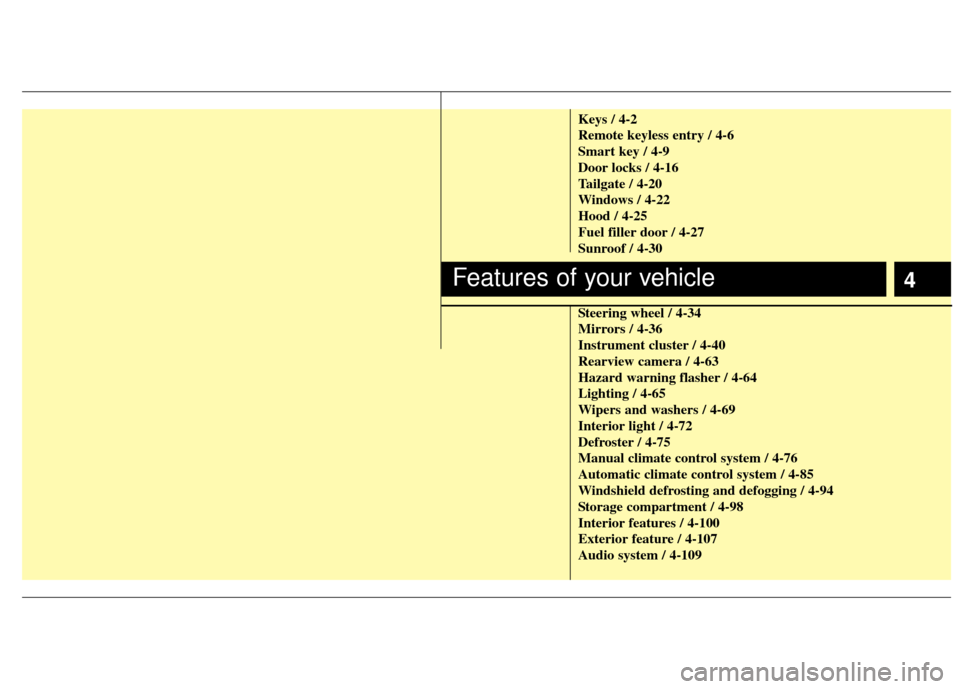
4
Keys / 4-2
Remote keyless entry / 4-6
Smart key / 4-9
Door locks / 4-16
Tailgate / 4-20
Windows / 4-22
Hood / 4-25
Fuel filler door / 4-27
Sunroof / 4-30
Steering wheel / 4-34
Mirrors / 4-36
Instrument cluster / 4-40
Rearview camera / 4-63
Hazard warning flasher / 4-64
Lighting / 4-65
Wipers and washers / 4-69
Interior light / 4-72
Defroster / 4-75
Manual climate control system / 4-76
Automatic climate control system / 4-85
Windshield defrosting and defogging / 4-94
Storage compartment / 4-98
Interior features / 4-100
Exterior feature / 4-107
Audio system / 4-109
Features of your vehicle
Page 106 of 393
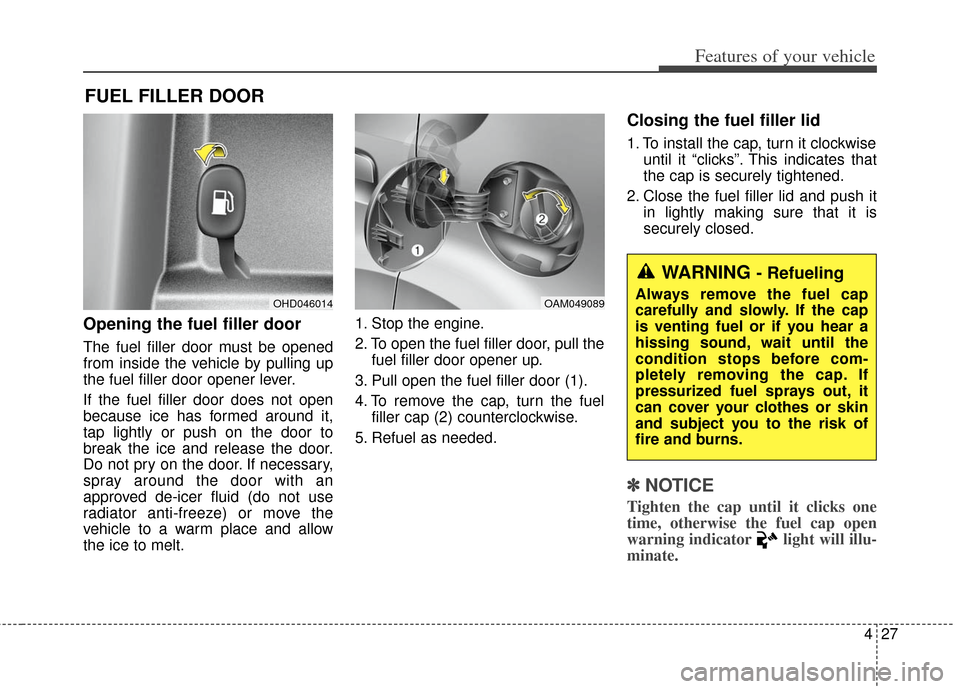
427
Features of your vehicle
Opening the fuel filler door
The fuel filler door must be opened
from inside the vehicle by pulling up
the fuel filler door opener lever.
If the fuel filler door does not open
because ice has formed around it,
tap lightly or push on the door to
break the ice and release the door.
Do not pry on the door. If necessary,
spray around the door with an
approved de-icer fluid (do not use
radiator anti-freeze) or move the
vehicle to a warm place and allow
the ice to melt.1. Stop the engine.
2. To open the fuel filler door, pull the
fuel filler door opener up.
3. Pull open the fuel filler door (1).
4. To remove the cap, turn the fuel filler cap (2) counterclockwise.
5. Refuel as needed.
Closing the fuel filler lid
1. To install the cap, turn it clockwise until it “clicks”. This indicates that
the cap is securely tightened.
2. Close the fuel filler lid and push it in lightly making sure that it is
securely closed.
✽ ✽NOTICE
Tighten the cap until it clicks one
time, otherwise the fuel cap open
warning indicator light will illu-
minate.
FUEL FILLER DOOR
OHD046014OAM049089
WARNING - Refueling
Always remove the fuel cap
carefully and slowly. If the cap
is venting fuel or if you hear a
hissing sound, wait until the
condition stops before com-
pletely removing the cap. If
pressurized fuel sprays out, it
can cover your clothes or skin
and subject you to the risk of
fire and burns.